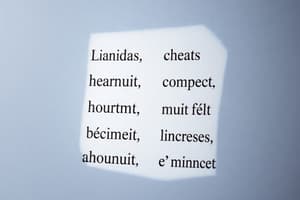Podcast
Questions and Answers
Match the following terms with their descriptions:
Match the following terms with their descriptions:
Complément d'Objet Direct (COD) = A noun or pronoun that directly follows the verb and is the object of the action. Complément d'Objet Indirect (COI) = A noun or pronoun that comes between the verb and its direct object.
Connect the examples with their correct type of object complement:
Connect the examples with their correct type of object complement:
Je vois la montagne. = Complément d'Objet Direct (COD) J'aime les romans de Walter Scott. = Complément d'Objet Direct (COD)
Match the preposition used with each type of object complement:
Match the preposition used with each type of object complement:
de = Complément d'Objet Direct (COD) à = Complément d'Objet Indirect (COI)
Pair the correct language term with its meaning:
Pair the correct language term with its meaning:
Match the following French grammar terms with their English translations:
Match the following French grammar terms with their English translations:
Match the following terms with their correct definitions in French grammar:
Match the following terms with their correct definitions in French grammar:
Match the following sentences with their correct identification of COD and COI:
Match the following sentences with their correct identification of COD and COI:
Match the following terms with their correct examples in sentences:
Match the following terms with their correct examples in sentences:
Match the following actions with their correct complements (COI or COD):
Match the following actions with their correct complements (COI or COD):
Flashcards
COD (Complément d'Objet Direct)
COD (Complément d'Objet Direct)
A noun or pronoun that directly receives the action of the verb; it's the direct object.
COI (Complément d'Objet Indirect)
COI (Complément d'Objet Indirect)
A noun or pronoun that indirectly receives the action of the verb; it's the indirect object.
Direct Object (Example)
Direct Object (Example)
In French grammar, the noun or pronoun that directly receives the action of a verb.
Indirect Object (Example)
Indirect Object (Example)
Signup and view all the flashcards
French Preposition (de)
French Preposition (de)
Signup and view all the flashcards
French Prepositions (à, pour, avec)
French Prepositions (à, pour, avec)
Signup and view all the flashcards
Differentiating COD and COI
Differentiating COD and COI
Signup and view all the flashcards
Common Misconception
Common Misconception
Signup and view all the flashcards
French Grammar Simplicity
French Grammar Simplicity
Signup and view all the flashcards
Study Notes
French Grammar: Compléments d'Objet Direct (COD) and Compléments d'Objet Indirect (COI)
If you've ever wondered why French seems to enjoy adding extra words to its sentences, welcome to the wonderful world of compléments d'objet. In the context of French grammar, we'll be examining two types: compléments d'objet direct (COD) and compléments d'objet indirect (COI), which are crucial for understanding how French expresses relationships between verbs and their objects.
Complément d'Objet Direct (COD)
COD, or direct object complement, is a noun or a pronoun that directly follows the verb and is the object of the action. In English, we don't usually need to mark this noun with a preposition, but in French, we typically use the preposition de to introduce the COD.
For example, consider the following sentence:
Je vois la montagne.
I see the mountain.
In this sentence, "la montagne" is the COD because it follows the verb (voir) and is the object of the action.
When you want to add information to the COD, you use the preposition de to connect it to the verb. For instance:
J'aime les romans de Walter Scott.
I like the novels by Walter Scott.
In this sentence, "les romans" is the COD, and "de Walter Scott" is an adjectival phrase that provides additional information about the COD by using the preposition de.
Complément d'Objet Indirect (COI)
COI, or indirect object complement, is a noun or a pronoun that comes between the verb and its direct object. In English, COI is often indicated by the prepositions "to," "for," or "with." In French, COI is often introduced by the prepositions à, pour, or avec.
Consider the following sentence:
Je donne un livre à mes amis.
I give a book to my friends.
In this sentence, "mes amis" is the COI because it comes between the verb (donner) and its direct object (un livre).
If you want to add information to the COI, you use the preposition de to connect it to the verb. For example:
Je donne un cadeau de céramique à ma mère.
I give a gift of ceramics to my mother.
In this sentence, "une cadeau de céramique" is the COI, and "de céramique" is an adjectival phrase that provides additional information about the COI by using the preposition de.
Misconceptions
One common misconception is that COI and COD are interchangeable. However, they serve different purposes in French grammar. COI typically provides the indirect recipient of the action, while COD provides the direct object of the action.
Another misconception is that French grammar is more complicated than English grammar. In reality, once you understand the basics of French grammar, including COD and COI, you'll find that French is a straightforward language that just requires extra words to express ideas.
Exercises
-
Translate the following English sentences into French and identify the COD and COI: a. I give a book to my friends. b. I saw a movie with my family. c. He cooked dinner for his guests.
-
Create French sentences that include COD and COI using the information from the previous sentences.
By understanding and practicing with these subtopics, you'll find that French grammar isn't as daunting as it first appears, and you'll be able to express your ideas clearly and confidently in this beautiful language.
Studying That Suits You
Use AI to generate personalized quizzes and flashcards to suit your learning preferences.




